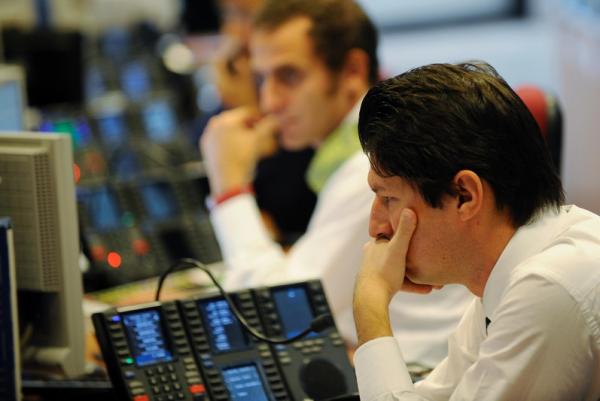Bank of America just raised its EUR/USD forecast
* China exports rise 3.5% y/y vs forecast -15.7%
* Weekly U.S. initial jobless claims reach 3.169 million
* Long-term U.S. yields lifted by tidal wave of new debt
* Turkey's lira slumps to record low
* Oil swings around $30 a barrel
By Marc Jones
LONDON, May 7 (Reuters) - World shares largely shook off
data on Thursday showing millions more Americans sought
unemployment benefits, with sentiment sustained by stronger than
expected Chinese exports.
Initial jobless claims for state unemployment benefits
totalled a seasonally adjusted 3.169 million for the week ended
May 2, down from a revised 3.846 million in the prior week,
showed the Labor Department's weekly jobless claims report.
The data reinforced economists' expectations of a protracted
recovery of the economy, which is reeling from nationwide
lockdowns to slow the spread of the coronavirus.
Earlier, stocks had been bolstered by Beijing reporting a
3.5% rise in exports in April on a year earlier, confounding
expectations of a 15.1% fall and outweighing a 14.2% drop in
imports. The surprise stoked speculation China could recover from its
coronavirus lockdown quicker than first thought and support
global growth in the process.
The news helped Japan's Nikkei .N225 and Seoul's Kopsi
.KS11 shake off early wobbles in Asia, and Europe's main
London .FTSE , Paris .FCHI and Frankfurt .GDAXI markets
extended gains, putting all of them roughly 1% higher. .EU
E-Mini futures for the S&P 500 ESc1 fared better with a
bounce of 1.5%, though there were ominous signs. Turkey's lira
fell to a record low amid worries about its dwindling FX
reserves and Italy's bond yields hit 2% again
before managing to recover. GVD/EUR O/R
"It's clear that this virus has gone from east to west and
we are now seeing that in the data," said Societe Generale's Kit
Juckes, pointing to the China numbers and relatively better
purchasing managing data in countries such as Australia.
But with the full economic impact of COVID-19 still to be
seen and huge amounts of debt potentially pushing up borrowing
costs, "the market is hugely split between die-hard bears and
buy-on-dip buyers", he added.
Markets had traded cautiously overnight with renewed
Sino-U.S. tensions lurking in the background.
U.S. President Donald Trump said he would be able to report
in about a week or two whether China is meeting its obligations
under a trade deal, as Washington weighed punitive action
against Beijing over its handling of the coronavirus outbreak.
The flow of economic data also remained grim, with U.S.
private employers laying off 20 million workers in April and the
Bank of England warning that the coronavirus crisis could cause
the country's biggest economic slump in 300 years.
"Despite their dizzying rally, we continue to be cautious on
equities in the near term," Luca Paolini, chief strategist at
asset manager Pictet said. "Markets seem to be overestimating
the speed of economic recovery."
WORLD'S BIGGEST BORROWER
Bond markets saw one of the largest shifts in a while after
the U.S. Treasury said it would borrow $2.999 trillion during
the June quarter, five times more than the previous
single-quarter record. US/
It will sell $96 billion next week alone and a surprising
amount of that will be at longer tenors, which in turn pushed up
long-term yields and steepened the curve.
Yields on 30-year Treasuries US30YT=RR steadied after
jumping 7 basis points to 1.40%, the largest daily increase
since mid-March. The early rise in Italy's yields to over 2%
reflected worries caused by a German court ruling this week
targeting the European Central Bank's bond purchase programme.
The rise in U.S. yields gave a lift to the U.S. dollar
versus most currencies and its index gained to 100.200 =USD .
The euro dropped below $1.08 EUR= , hurt too by a gloomy
economic outlook from the European Commission. The single currency sank to its lowest against the Japanese
yen since late 2016 at 114.40 EURJPY= , and even the dollar
touched a seven-week trough at 105.98 yen JPY= before bouncing
to 106.55 yen in Europe.
"There's a lot to like about the yen these days," said
Deutsche Bank's global head of G10 FX Alan Ruskin.
He noted that with rates across the globe falling to all-
time lows, the yen no longer had a large yield disadvantage.
"Across all of 3m, 2y, 5y and long-end tenors, the average
spread between yen rates and the average of G10 yields are at
lows not seen for at least the last three decades," he said.
The yen was also cheap by many measures, he argued, with
fair value put at around 85 per dollar.
In commodity markets, conditions were changeable again. Gold
had eased on expectations that supplies will grow as bullion
refineries resume operations but turned higher to sit at $1,693
an ounce XAU= ahead of U.S. trading. GOL/
Oil prices were still wild, swinging from 1% down to 6%
higher after a six-session streak of gains which has seen Brent
almost double from a 21-year low hit in April. O/R
Brent crude LCOc1 futures were up $1.80 at $31.59 a
barrel, while U.S. crude CLc1 had climbed from $23.85 to
$26.40.
<^^^^^^^^^^^^^^^^^^^^^^^^^^^^^^^^^^^^^^^^^^^^^^^^^^^^^^^^^^^
Asia stock markets https://tmsnrt.rs/2zpUAr4
Asia-Pacific valuations https://tmsnrt.rs/2Dr2BQA
Stocks and oil lift out of coronavirus slump IMAGE https://tmsnrt.rs/2W6G3f2
Turkey eroding financial buffer png https://tmsnrt.rs/3bR8V0k
^^^^^^^^^^^^^^^^^^^^^^^^^^^^^^^^^^^^^^^^^^^^^^^^^^^^^^^^^^^>
